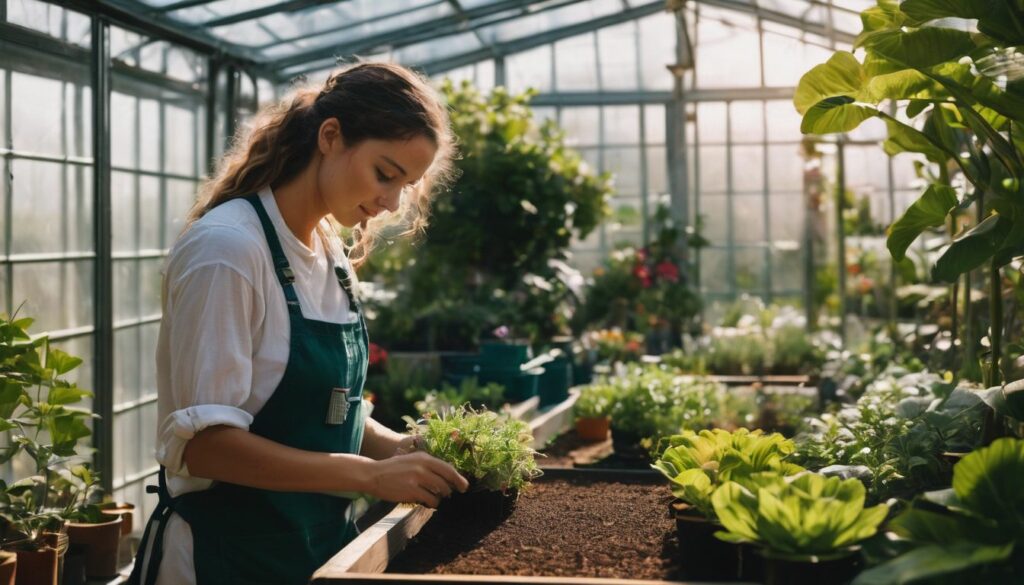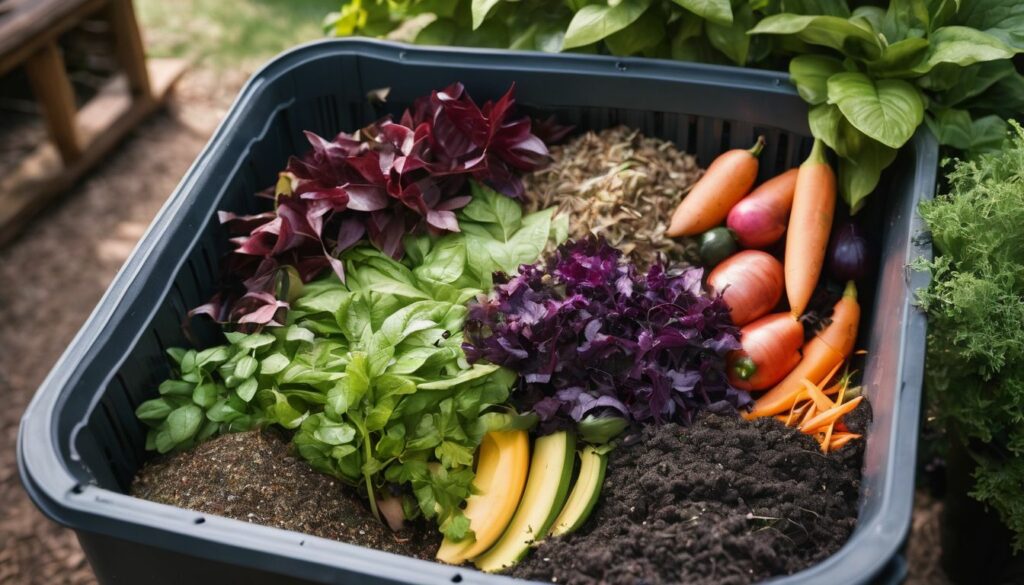Have you ever found yourself knee-deep in your vegetable patch, wrestling the tough soil and daydreaming of easier ways? Believe me, we’ve all been there. Then I stumbled upon the concept of no-till gardening that produces up to 10 times more crops than traditional methods! There’s a certain sparkle about it – and it’s not just because of bigger harvests either.
This blog post will take a deep dive into the multitude of benefits and essentials of no-till gardening. So, are you ready to shake up your gardening routine? Let’s dig in!
Key Takeaways
- No – till gardening offers numerous benefits, including higher crop yields, healthier soil, and reduced time and effort required.
- Tilling can disrupt the natural structure of the soil and lead to increased weed growth and soil erosion.
- To practice no – till gardening, create new beds without disturbing the existing soil structure by using cardboard or newspaper to smother weeds, adding compost or manure for nutrients, and covering with mulch.
- Mulching is a fundamental principle of no – till gardening that helps retain moisture in the soil, prevent weed growth, improve soil structure, conserve water, and promote beneficial organisms.
Understanding No-Till Gardening
No-till gardening offers numerous benefits and avoids the drawbacks of tilling, making it a sustainable and efficient method for cultivating plants.
Benefits of no-till gardening
No-till gardening is full of good things. It helps plants fight dry times. Your garden will yield up to 10 times more with no-till! You also save time and work less. Plus, you have healthier soil and better crops like big red tomatoes! This way of gardening uses less gas for tools too.
It’s great for the earth because it adds organic matter to the soil. Soil stays strong and weed seeds stay buried instead of sprouting annoying weeds! No-till aligns with a love for nature and growing things right.
The downside of tilling
Tilling, or digging up the soil, may seem like a common gardening practice, but it actually has some downsides. When we till the soil, we disrupt its natural structure and break up important microorganisms that help plants grow.
This can lead to increased weed growth and soil erosion. Tilling also requires a lot of time and effort, as well as the use of fossil fuels if using machinery. Instead of tilling, I prefer the no-till gardening method because it helps preserve the soil’s health and structure while still allowing me to grow healthy and productive plants.
Fundamentals of No-Till Gardening
To practice no-till gardening, it’s important to create new beds without disturbing the existing soil structure and mimic natural processes by mulching instead of digging.
Creating new beds
When creating new beds for no-till gardening, I start by clearing the area of any existing vegetation. Then, I lay down a thick layer of cardboard or newspaper to smother any remaining weeds and grass.
This acts as a natural weed barrier and helps to break down organic matter. Next, I add a layer of compost or well-rotted manure on top of the cardboard or newspaper. This provides nutrients for my plants as they grow.
Finally, I cover the bed with a layer of mulch, such as straw or wood chips, to help retain moisture in the soil and suppress weed growth. By following these steps, I can create healthy and productive beds for my no-till garden without disrupting the soil ecosystem or causing soil erosion.
Mimicking natural processes
Mimicking natural processes is a fundamental aspect of no-till gardening. Instead of overturning the soil and disturbing its ecosystem, we aim to recreate nature’s way of doing things.
By leaving the soil undisturbed, we allow beneficial organisms like earthworms and microorganisms to thrive. These organisms help break down organic matter, improving soil structure and fertility.
Mimicking natural processes also involves using mulch instead of digging to suppress weeds and retain moisture in the soil. This low-maintenance technique helps conserve water, prevents soil erosion, and promotes a healthier garden overall.
Mulching instead of digging
When it comes to no-till gardening, one of the fundamental principles is mulching instead of digging. Mulching involves covering the soil surface with a layer of organic materials like wood chips, straw, or leaves.
This protective layer acts as a barrier that helps retain moisture in the soil and prevents weed growth. By mulching, you can improve soil structure, enhance fertility, and reduce erosion.
It also creates a favorable environment for beneficial microorganisms and earthworms to thrive, which further contributes to the health of your garden. Additionally, mulching helps regulate temperature fluctuations in the soil and conserves water by reducing evaporation.
Different Methods of No-Till Gardening
There are several different methods of no-till gardening, including the sheet mulch method, instant soil method, and square foot gardening method.
Sheet mulch method
One effective method of practicing no-till gardening is the sheet mulch method. This involves layering organic materials, such as cardboard, newspaper, straw, and compost, directly over the existing soil to create a natural mulch.
The layers of organic matter act as a barrier that suppresses weeds and retains moisture in the soil. As these materials break down over time, they enrich the soil with nutrients and improve its structure.
Sheet mulching also helps to conserve water by reducing evaporation from the soil surface. By employing this low-maintenance technique, gardeners can establish new beds without having to dig or overturn the soil, preserving its ecosystem and promoting sustainable gardening practices.
Instant soil method
The instant soil method is a quick and easy way to start a no-till garden. Instead of spending time digging and tilling the soil, you can create an instant bed for your plants. First, choose a sunny spot for your garden.
Lay down a layer of cardboard or newspaper on top of the grass or weeds to smother them. Then, cover the area with compost or organic matter about three inches thick. This will provide nutrients for your plants and create a rich growing environment.
Finally, add a layer of mulch on top to help conserve moisture and prevent weed growth. With the instant soil method, you can have a thriving garden without all the hard work of tilling!
Square foot gardening method
Square foot gardening is a simple and efficient method of no-till gardening that maximizes space and minimizes work. In square foot gardening, you divide your garden into small 1-foot by 1-foot squares, each containing a specific plant or crop.
By planting in smaller areas, you can grow more in less space.
This method promotes high yields because it optimizes the use of soil nutrients and water. It also reduces weed growth since plants are closely spaced together, shading out potential weeds.
Square foot gardening is a low maintenance technique that requires less digging and weeding compared to traditional gardening methods.
To start square foot gardening, you need to build raised beds or boxes for each square foot section. Fill these beds with nutrient-rich soil mixtures to provide ample nutrition for your crops.
Then, plan which plant goes where according to their spacing requirements.
Maintaining Healthy Soil in No-Till Gardens
To keep your no-till garden thriving, follow these essential steps for soil health and read more about sustainable gardening techniques.
Crop rotation
Crop rotation is an important practice in no-till gardening. It involves changing the type of crops grown in a specific area from one year to another. This helps prevent the build-up of pests and diseases, as well as nutrient depletion in the soil.
By rotating crops, we can maintain a healthier soil ecosystem and improve overall soil fertility. Additionally, crop rotation reduces weed growth and improves water conservation. It’s a simple but effective technique that contributes to sustainable and organic gardening practices while promoting better yields and healthier plants.
Cover crops
Cover crops are an essential aspect of no-till gardening. They are plants that are purposely grown to cover the soil during periods when there are no cash crops being cultivated. Cover crops play a crucial role in maintaining soil health and fertility.
They help prevent soil erosion, suppress weed growth, improve water retention, and add organic matter to the soil when they decompose. Additionally, cover crops enhance biodiversity by providing habitats for beneficial insects and microorganisms.
By incorporating cover crops into our gardening practices, we can support a healthy soil ecosystem and promote sustainable agriculture.
Avoiding walking in beds
When gardening using the no-till method, it’s important to avoid walking on the beds. Walking on the beds can compact the soil and disrupt its structure, making it harder for plants to grow.
Compacted soil also hampers water and nutrient absorption by plant roots. By avoiding walking in the beds, you can preserve a loose and aerated soil structure that promotes healthy root development and allows plants to thrive.
It’s best to create designated paths between your garden beds where you can walk without disturbing the soil. This simple practice will help maintain a healthy growing environment for your plants, leading to better yields and healthier crops in your no-till garden.
Adding organic matter
Adding organic matter is a crucial aspect of maintaining healthy soil in no-till gardens. Organic matter, such as compost or decomposed plant material, helps to improve the soil structure and fertility.
It provides essential nutrients for plants and encourages beneficial microbial activity in the soil. By adding organic matter regularly, we can enhance water retention, reduce erosion, and suppress weed growth.
This sustainable practice also promotes carbon sequestration and supports the overall health of our garden ecosystem.
Mulching regularly
Mulching regularly is an important practice in no-till gardening. By covering the soil with a layer of organic matter, such as straw or wood chips, mulching helps to retain moisture and suppress weed growth.
This reduces the need for watering and weeding, making it a low maintenance technique. Mulching also improves soil structure and fertility by adding organic matter as it breaks down over time.
Additionally, mulch acts as a protective barrier against erosion, preventing valuable topsoil from being washed away during heavy rains. Overall, regular mulching promotes healthier soil and better gardening results in a sustainable and efficient way.
No-Till Gardening for the Future
No-till gardening is not just a trend, but a sustainable practice that holds great promise for the future of gardening. As we face increasing challenges such as water scarcity and climate change, adopting no-till methods can help us grow food in a more efficient and environmentally-friendly way.
With its focus on preserving soil health and reducing disturbance, no-till gardening offers numerous benefits. It helps to prevent soil erosion, conserve water, and promote biodiversity in the soil ecosystem.
By avoiding the use of heavy machinery and minimizing the need for synthetic fertilizers and pesticides, no-till gardening also contributes to reducing our carbon footprint. This low-maintenance technique fosters healthy plant growth while ensuring long-term soil fertility.
With its potential to increase crop yields while protecting our natural resources, no-till gardening is indeed an approach that can lead us towards a greener and more sustainable future.
Conclusion
In conclusion, no-till gardening offers numerous benefits for both the gardener and the environment. By mimicking natural processes and avoiding tilling, we can create healthier soil, increase yields, and conserve water.
With its low-maintenance techniques and focus on sustainability, no-till gardening is a promising method for the future of gardening. So why not give it a try and discover the advantages and fundamentals of no till gardening yourself? Your plants will thank you!
FAQs
1. What is No Till Gardening?
No till gardening is a method of organic farming where soil isn’t turned over. It uses methods like composting and mulched crops for soil coverage to keep it healthy.
2. How does no till gardening help in conservation agriculture?
By not overturning the soil, no till gardening prevents soil erosion and supports regenerative agriculture, which helps nature stay balanced.
3. Is weed control possible with no till garden methods?
Yes! With techniques such as square foot gardening and low-till gardening, weeds can be suppressed without harming the environment or using harmful chemicals.
4. Can I start a no till garden at home using compost?
Definitely! You make an instant compost topsoil pile at home to begin your own natural garden by following permaculture principles.





